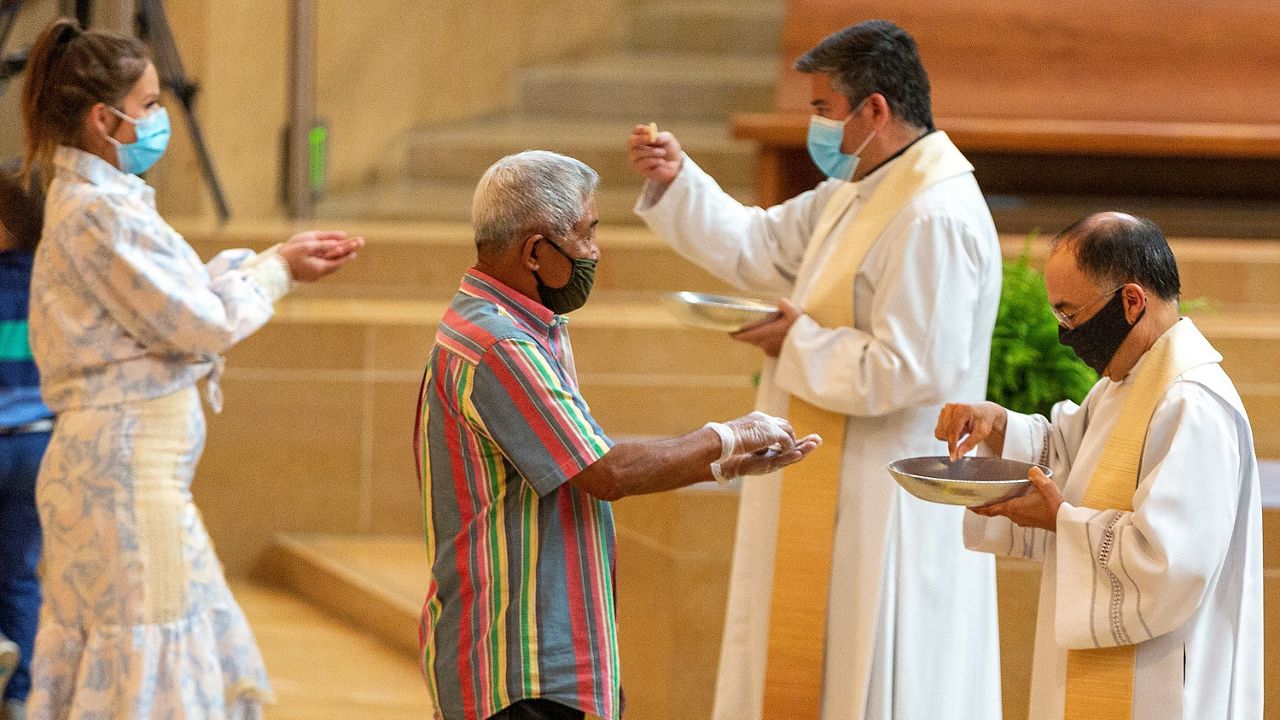CINCINNATI — The Archdiocese of Cincinnati on Sunday released the final details of its reconfiguration plan that will consolidate its 208 existing parishes into 57 “families of parishes.” The changes will also affect the distribution of priests and other diocesan staff and could, down the road, impact the future of some local Catholic schools.
What You Need To Know
- The move consolidates 208 parishes into 57 'families of parishes'
- The move will also affect priest and staff distribution and potentially operations at local Catholic schools
- The Archdiocese initiated the Beacons of Light two years ago to address mounting challenges
- Changes start to go into effect this summer
Archbishop Dennis M. Schnurr announced the final Beacons of Light plan in person to the faithful attending the 11 a.m. Sunday Mass at Cathedral Basilica of St. Peter in Chains in downtown Cincinnati. He also recorded a message that played at all Masses across the Archdiocese this weekend.
He's "convinced" that this process "born of great hope, will enable us to form stronger parishes, centered on the Eucharist, that radiate the love of Christ and joy of the Gospel in a world that is frequently indifferent or even hostile."
In his comments, Schnurr stressed an understanding that the moves may be "difficult" for some to accept given years-old connections to specific churches and related traditions. But he believes in the end the moves will have a "powerful and positive impact" on the future of this Archdiocese.
The changes are a byproduct of a long-term planning initiative the Archdiocese initiated two years ago called Beacons of Light. The goal was to look at the current status of the local Catholic Church and come up with a realistic plan for moving forward given ongoing challenges.
Issues range from decreased Mass attendance to fewer kids enrolled in diocesan schools to a rapidly declining number of priests. The Archdiocese said the existing number of priests, many of whom are at or over retirement age, are already stretched too thin.
Beyond its more than 200 churches, the Archdiocese has 112 primary and secondary schools and other facilities spread across its 19-country area in southwestern and southern Ohio.
How it will work
There are six regional quadrants across the 19-county Archdiocese. Each quadrant contains several parish families. The size of each family stems from a combination of factors, including geography, the listed number of Roman Catholic households in a specific parish and average Mass attendance at each church.
The largest parish families include six churches. An example is the family labeled South 7, which is made up of St. Bartholomew, Assumption, St. Vivian, St. Clare, Mother of Christ and St. Bernard (Spring Grove Village). It has two priests assigned to it.
The neighboring parish family, South 4, has four churches and three priests. St. Gertrude in Madeira is the only parish in South 13. It has two priests.
Schnurr told the congregants this weekend that he's "convinced" the reconfiguration will allow the Archdiocese to "form stronger parishes" centered around the church teachings.
In spring 2022, the Archdiocese will outline priest assignments. The implementation of families of parishes will formally begin July 1, 2022.
You can see the map of the new configuration below.
The need for change
Schnurr said much of the existing infrastructure was built or purchased to accommodate a different era. The Archdiocese of Cincinnati celebrated its bicentennial earlier this year.
Today, across the Archdiocese there are about 160,000 registered Catholic households, housing about 442,000 people. Those numbers may seem high, but they're really small compared to historic highs of nearly 600,000.
For perspective, while Philadelphia and Detroit have roughly the same number of parishes as Cincinnati, those dioceses each have more than 1 million Catholics.
Religious practice has been declining in both the United States and in the Cincinnati region.
From 2010 to 2019, local sacramental practice — things like baptisms, first communions and weddings — dropped by roughly 23%, per the Archdiocese. They said school enrollment fell 14% over that same period.
The Archdiocese said their facilities are "grossly underutilized."
The average Sunday Mass is about one-third full, per the Archdiocese. While still one of the largest Catholic school systems in the country, the numbers have dropped significantly over the years. In 1970, there were 105,000 students in Catholic schools in Cincinnati, while today it's closer to 44,000, a nearly 60% drop.
There are only 140 active priests available for assignment across the 200-plus parishes in the Archdiocese; 26 of them are over the age of 70. Projections call for that number to decline by 20% over the next five years.
"We have a responsibility to make the best use of all the means which God has provided us to pursue this sacred mission. The purpose of Beacons of Light is to ensure that all our resources – human, physical and financial – are properly ordered to missionary discipleship," Schnurr wrote in a letter to parishioners.
For the past two years, the Archdiocese has collected data from its schools and churches. Working with a consulting group, they came up with several rounds of modeling of possible configurations.
In October, the Archdiocese of Cincinnati presented a draft of the plan to parishioners for their review and feedback. The open comment period elicited nearly 8,000 comments and has resulted in several changes to the configuration.
"Thank you to the thousands of Catholics in the archdiocese who have been engaged in this initiative over the last several months. Your thoughtful feedback has significantly shaped this phase of our pastoral planning and for that I am deeply grateful," Schnurr said.
More information about Beacons of Light, including frequently asked questions and downloadable resources are available at BeaconsAOC.org.
Families of Parishes by Lydia Taylor on Scribd



